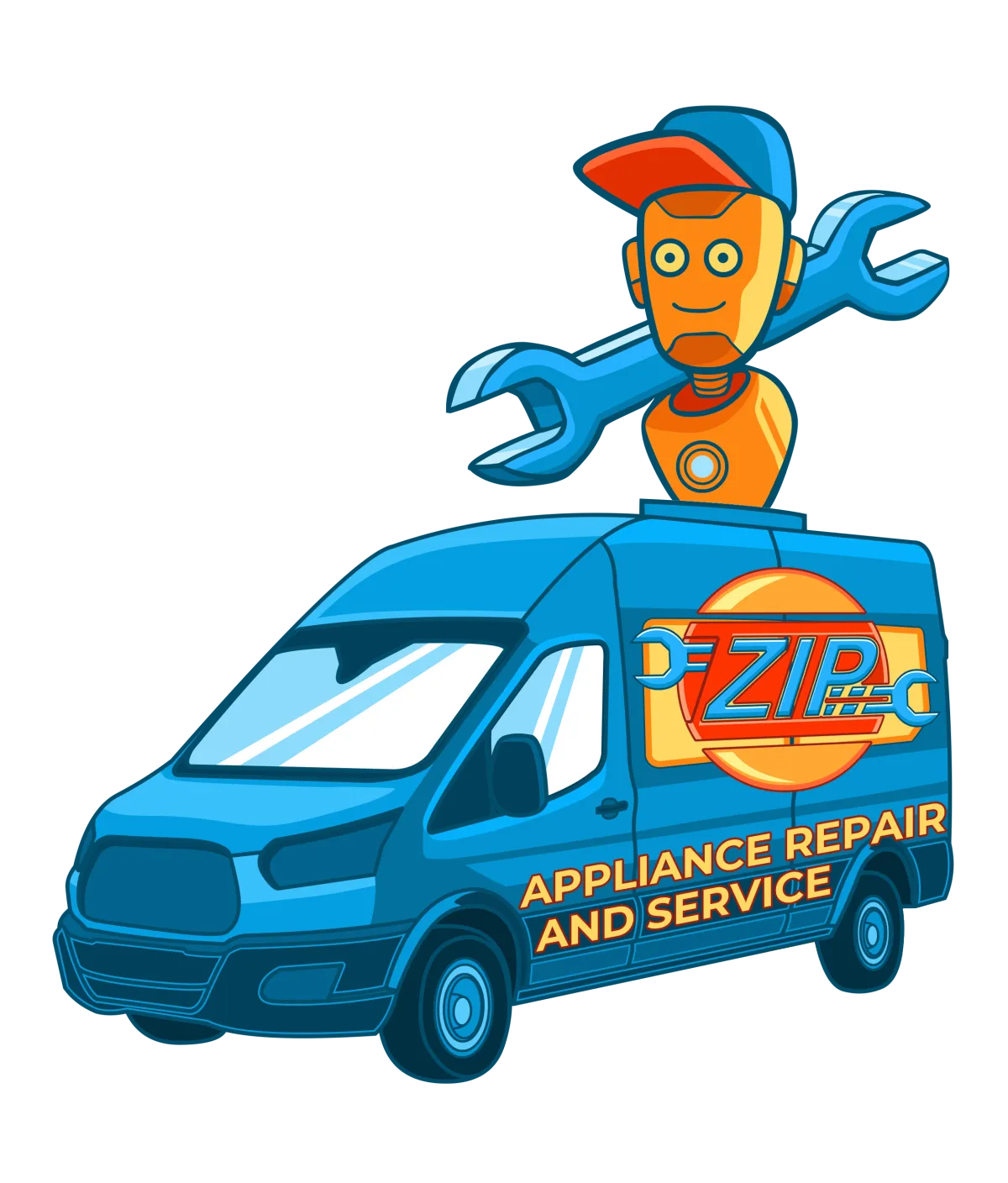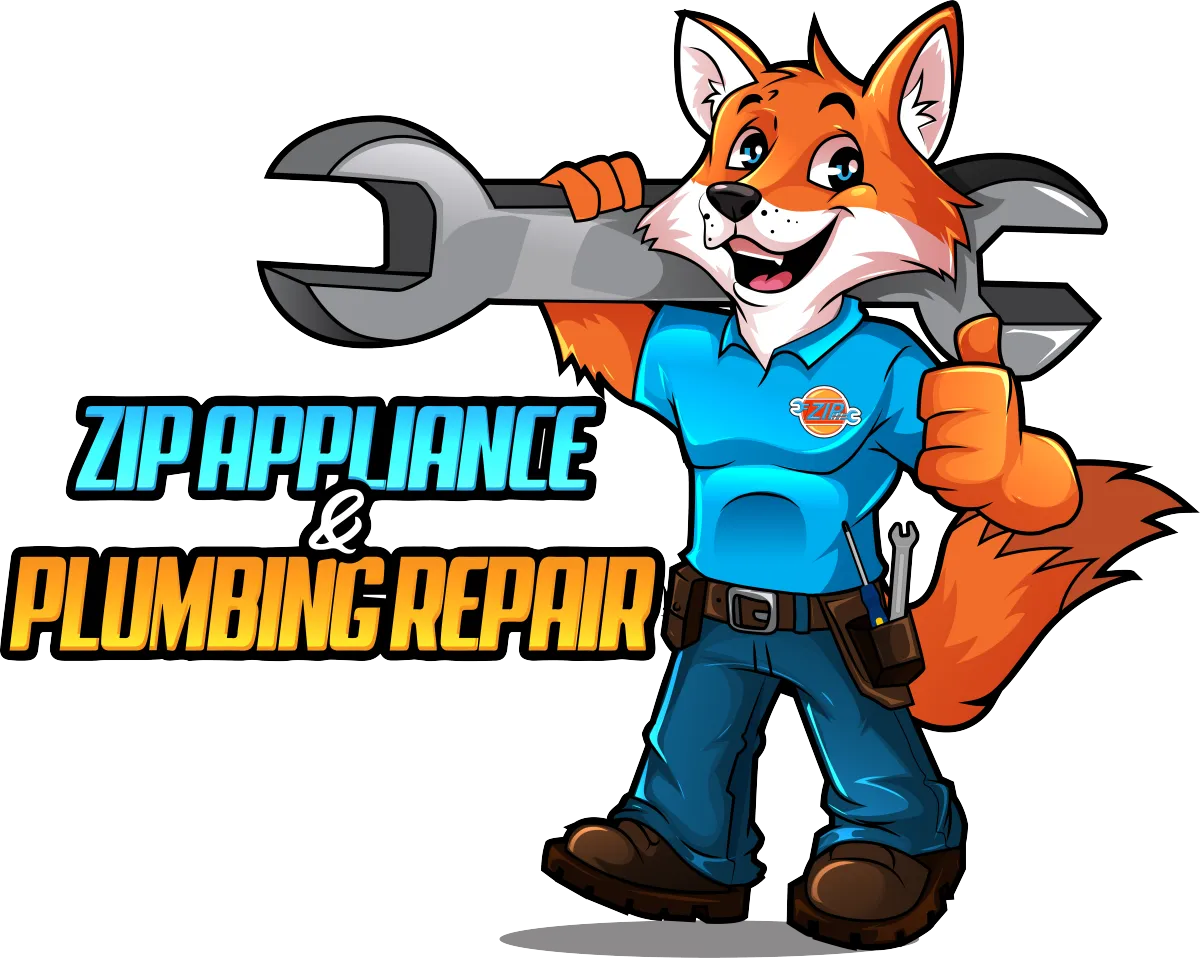Phone: (559) 272-4265
Appliance Repair Tips For Bakersfield, CA Residents

Fix Your Whirlpool Washer: DIY Troubleshooting and Repair Guide
“Empower yourself with the knowledge to keep your Whirlpool washer running smoothly. This DIY Troubleshooting and Repair Guide from Zip Appliance and Plumbing Repair offers comprehensive steps, safety tips, and expert insights to help you tackle common issues and maintain your appliance with confidence.” - Appliance Boss
Introduction:
Your Whirlpool washer is a reliable workhorse in your household, making laundry tasks efficient and straightforward. However, like any appliance, it requires regular maintenance and occasional repairs to keep it running optimally. This guide aims to empower you with the knowledge and confidence to troubleshoot and repair your Whirlpool washer yourself, saving you both time and money.
Importance of Maintaining Your Whirlpool Washer
Regular maintenance of your Whirlpool washer is crucial for its longevity and performance. Neglecting routine upkeep can lead to minor issues escalating into major repairs, costly breakdowns, and even the need for a replacement. A well-maintained washer operates more efficiently, uses less energy, and ensures your clothes are cleaned effectively every time.

Benefits of DIY Troubleshooting and Repairs
Undertaking DIY repairs not only saves on service fees but also gives you a deeper understanding of your appliance. By learning how to fix common issues, you can address problems immediately, reducing downtime and inconvenience. Additionally, the sense of accomplishment and self-reliance that comes from successfully repairing your washer is immensely satisfying.
Safety Precautions Before Starting
Before diving into any repair, it's essential to prioritize safety. Always disconnect your washer from the power source to prevent electrical shocks. Ensure the water supply is turned off to avoid flooding. Wear protective gloves and eyewear to safeguard against any sharp components or chemical cleaning agents. By taking these precautions, you create a safe environment for your DIY endeavors.
Understanding Your Whirlpool Washer
Overview of Whirlpool Washer Models
Whirlpool offers a range of washer models, each designed with specific features and technologies to cater to various household needs. Understanding the model you own is the first step in effective troubleshooting. Whether you have a top-loader or a front-loader, knowing its specifications will guide you in identifying and resolving issues.
Key Components and Their Functions
Familiarize yourself with the essential components of your washer. These include the drum, agitator, motor, pump, water inlet valves, and control panel. Each part plays a vital role in the washing process, from filling the drum with water to spinning and draining. Knowing these functions helps in pinpointing where problems might arise.
Common Issues Faced by Whirlpool Washer Owners
Whirlpool washers, like all appliances, can encounter specific problems. Common issues include the washer not starting, failing to fill with water, not draining properly, not spinning, and leaking water. Understanding these typical problems and their symptoms allows you to diagnose issues more accurately and take appropriate action.
Tools and Materials Needed
Essential Tools for Washer Repair
Having the right tools on hand is crucial for effective repairs. Essential tools include screwdrivers, pliers, a wrench set, a multimeter for electrical testing, and a flashlight for better visibility. These basic tools will cover most repair needs for your washer.
Recommended Materials and Parts
In addition to tools, you may need specific replacement parts and materials such as fuses, hoses, belts, and gaskets. It's beneficial to have a repair manual for your specific model and any necessary cleaning agents to maintain your washer during repairs.
Where to Purchase Replacement Parts
Genuine Whirlpool parts can be purchased from authorized dealers, online retailers, and appliance repair shops. Ensure you have your washer's model number handy to get the correct parts. Investing in authentic parts guarantees better performance and longevity for your repairs.
Identifying the Problem
Visual Inspection: What to Look For
Start with a thorough visual inspection. Look for obvious signs of wear and tear, loose components, or visible damage. Check for any water leakage, rust, or unusual residue. A detailed inspection often reveals the root cause of many issues.
Listening for Unusual Sounds
Unusual sounds can be a key indicator of internal problems. Listen for grinding, squeaking, or banging noises during the washer’s operation. These sounds can signal issues with the motor, drum, or other moving parts, helping you to narrow down the potential problems.
Checking Error Codes and What They Mean
Modern Whirlpool washers come equipped with digital displays that show error codes when something goes wrong. Refer to your user manual to decipher these codes, as they provide valuable insights into specific issues like drainage problems, door lock failures, or sensor errors.

Troubleshooting Common Issues
Washer Not Starting: Possible Causes and Fixes
If your washer won't start, check the power supply first. Ensure the washer is plugged in and the outlet is functioning. Inspect the door latch, as a faulty latch can prevent the washer from starting. Also, examine the control board for any signs of damage or malfunction.
Washer Not Filling with Water: Steps to Diagnose and Repair
When your washer doesn’t fill with water, inspect the water inlet hoses for blockages or kinks. Check the water inlet valves for proper operation and ensure they are fully open. A malfunctioning water level sensor can also cause this issue and may need to be replaced.
Washer Not Draining: Common Problems and Solutions
A washer that won't drain could have a clogged drain hose or pump. Remove and clean the drain hose, checking for obstructions. Inspect the pump for any debris that may be causing a blockage. If the pump is damaged, it may need to be replaced.
Washer Not Spinning: Troubleshooting Tips
If your washer isn't spinning, it could be due to an unbalanced load, a broken drive belt, or a faulty motor coupling. Redistribute the load and try again. If the issue persists, inspect the drive belt and motor coupling for wear and replace them if necessary.
Washer Leaking Water: Identifying and Fixing Leaks
Water leaks can originate from various points in your washer. Check the door seal for damage or dirt buildup that could prevent a proper seal. Inspect the water inlet hoses and drain hose for leaks or loose connections. Additionally, ensure the detergent drawer is clean and properly closed.
Fixing Electrical Issues
Checking and Replacing Fuses
A blown fuse can disrupt the washer's operation. Locate the fuse box and check for any blown fuses. Replace any faulty fuses with ones that match the correct amperage to restore power to your washer.
Inspecting the Power Cord and Connections
Examine the power cord for any signs of damage, such as fraying or cuts. Ensure all connections are secure and free from corrosion. Replace the power cord if you find any defects to prevent electrical hazards.
Repairing or Replacing the Control Board
The control board is the brain of your washer, coordinating all functions. If it’s malfunctioning, the washer may not operate correctly. Inspect the board for burnt components or loose connections. If necessary, replace the control board to restore proper functionality.
Addressing Mechanical Problems
Fixing a Faulty Lid Switch
A defective lid switch can prevent the washer from starting or spinning. Test the switch with a multimeter to check for continuity. If it’s faulty, replace the lid switch to ensure the washer operates correctly.
Replacing a Broken Drive Belt
The drive belt connects the motor to the drum, enabling it to spin. If the belt is broken or worn out, replace it by removing the washer’s back panel and installing a new belt around the motor pulley and drum.
Repairing or Replacing the Motor Coupler
The motor coupler connects the motor to the transmission. If it breaks, the washer won’t agitate or spin. Access the coupler by removing the motor and transmission assembly, then replace it with a new one.
Dealing with Water Supply Issues
Inspecting Water Inlet Valves
Water inlet valves control the flow of water into the washer. If they’re clogged or malfunctioning, clean or replace them. Ensure they open and close properly to maintain the correct water flow.
Cleaning or Replacing Water Hoses
Regularly inspect water hoses for cracks, leaks, or blockages. Clean the hoses to remove any buildup and replace them if they show signs of wear. Using high-quality hoses can prevent future leaks and bursts.
Checking Water Pressure and Flow
Ensure your home’s water pressure is adequate for the washer. Low water pressure can affect filling and rinsing. Check for any blockages in the plumbing system that might be restricting water flow to the washer.
Solving Drum and Agitator Problems
Diagnosing Drum Movement Issues
If the drum doesn’t move smoothly, it could be due to worn bearings or a damaged drum belt. Inspect the drum’s suspension system and replace any faulty parts to ensure smooth operation.
Repairing or Replacing the Agitator
The agitator helps to move clothes around during the wash cycle. If it’s not functioning, check for worn-out agitator dogs or a broken agitator assembly. Replace the defective parts to restore proper agitation.
Balancing the Washer Drum
An unbalanced drum can cause excessive vibration and noise. Ensure the washer is level and adjust the feet if necessary. Distribute the laundry evenly inside the drum to maintain balance during the wash cycle.
Handling Noise and Vibration
Identifying Sources of Noise
Unusual noises can indicate problems with the washer’s components. Listen carefully to pinpoint the source, such as a loose drum, worn bearings, or foreign objects inside the drum.
Tightening Loose Parts
Loose parts can create noise and vibration. Check all screws, bolts, and nuts to ensure they are tight. Pay special attention to the drum, motor, and suspension system.
Adding Anti-Vibration Pads
Anti-vibration pads can help reduce noise and movement. Place these pads under the washer’s feet to absorb vibrations and keep the machine stable during operation.
Maintaining the Washer
Regular Cleaning Routines
Keep your washer clean to ensure optimal performance. Wipe down the drum, door seal, and detergent drawer regularly. Run a cleaning cycle with a washer cleaner or vinegar to remove residue and odors.
Descaling and Removing Detergent Buildup
Hard water and detergent can leave deposits inside the washer. Use a descaling solution to remove limescale and prevent buildup. Clean the detergent drawer and dispenser regularly to avoid clogging.
Lubricating Moving Parts
Lubricate the washer’s moving parts, such as the drum bearings and motor, to reduce friction and wear. Use a suitable lubricant recommended by the manufacturer for best results.
Preventative Measures
Tips to Avoid Common Problems
Avoid overloading the washer, use the correct detergent, and follow the manufacturer’s guidelines. Regularly inspect hoses and seals for wear and tear to prevent leaks.
Best Practices for Loading the Washer
Distribute clothes evenly in the drum and avoid overloading. Mix large and small items for balanced loads. This ensures effective cleaning and reduces strain on the washer’s components.
Importance of Regular Maintenance Checks
Schedule regular maintenance checks to keep your washer in top condition. Inspect key components, clean filters, and run diagnostic tests to catch potential issues early.
When to Call a Professional
Signs That Indicate a Professional Is Needed
If you encounter complex electrical problems, major leaks, or significant mechanical failures, it’s best to call a professional. Persistent issues that don’t resolve with DIY efforts also warrant expert intervention.
Finding a Reliable Repair Service
Look for certified Whirlpool repair technicians with good reviews and reasonable rates. Ask for recommendations from friends or check online reviews to find a trustworthy service.
Understanding Warranty Coverage
Check your washer’s warranty before attempting any repairs. Some fixes might be covered, saving you money. Ensure any professional work doesn’t void the warranty.
DIY Success Stories
Real-Life Examples of Successful Repairs
Read about homeowners who’ve successfully repaired their Whirlpool washers. These stories provide inspiration and practical insights into tackling common issues.
Tips from Other DIY Enthusiasts
Learn from the experiences of other DIYers. They often share valuable tips and tricks that can make your repair process smoother and more efficient.
Encouraging Words for First-Time DIYers
Embarking on DIY repairs can be daunting. Remember, every expert started as a beginner. Take your time, follow instructions carefully, and celebrate your successes, no matter how small.
Frequently Asked Questions
Commonly Asked Questions About Whirlpool Washer Repairs
Find answers to the most frequently asked questions about Whirlpool washer repairs. This section covers common concerns and provides clear, concise solutions.
Expert Answers and Advice
Benefit from expert advice on troubleshooting and repairing your washer. Detailed explanations help you understand the intricacies of your appliance.
Additional Resources for Troubleshooting
Access a list of additional resources, including video tutorials, repair manuals, and support forums. These can offer further guidance and support for your DIY repair journey.
Conclusion
Recap of Key Points
Review the essential tips and steps covered in this guide. A quick recap reinforces the main points and ensures you’re ready to tackle any washer issue.
Encouragement to Try DIY Repairs
Don’t be afraid to try DIY repairs. With the right tools, knowledge, and confidence, you can save money and keep your washer running smoothly.
Final Safety Reminders
Always prioritize safety in your repair efforts. Follow the recommended precautions, and don’t hesitate to seek professional help if needed. Your safety and the proper functioning of your washer are paramount.
For professional assistance, contact Zip Appliance and Plumbing Repair. Visit our website at www.ziprepairservice.com or call us at (661) 387-2282. We’re here to help with all your appliance and plumbing needs in Bakersfield, California.

Fix Your Whirlpool Washer: DIY Troubleshooting and Repair Guide
“Empower yourself with the knowledge to keep your Whirlpool washer running smoothly. This DIY Troubleshooting and Repair Guide from Zip Appliance and Plumbing Repair offers comprehensive steps, safety tips, and expert insights to help you tackle common issues and maintain your appliance with confidence.” - Appliance Boss
Introduction:
Your Whirlpool washer is a reliable workhorse in your household, making laundry tasks efficient and straightforward. However, like any appliance, it requires regular maintenance and occasional repairs to keep it running optimally. This guide aims to empower you with the knowledge and confidence to troubleshoot and repair your Whirlpool washer yourself, saving you both time and money.
Importance of Maintaining Your Whirlpool Washer
Regular maintenance of your Whirlpool washer is crucial for its longevity and performance. Neglecting routine upkeep can lead to minor issues escalating into major repairs, costly breakdowns, and even the need for a replacement. A well-maintained washer operates more efficiently, uses less energy, and ensures your clothes are cleaned effectively every time.

Benefits of DIY Troubleshooting and Repairs
Undertaking DIY repairs not only saves on service fees but also gives you a deeper understanding of your appliance. By learning how to fix common issues, you can address problems immediately, reducing downtime and inconvenience. Additionally, the sense of accomplishment and self-reliance that comes from successfully repairing your washer is immensely satisfying.
Safety Precautions Before Starting
Before diving into any repair, it's essential to prioritize safety. Always disconnect your washer from the power source to prevent electrical shocks. Ensure the water supply is turned off to avoid flooding. Wear protective gloves and eyewear to safeguard against any sharp components or chemical cleaning agents. By taking these precautions, you create a safe environment for your DIY endeavors.
Understanding Your Whirlpool Washer
Overview of Whirlpool Washer Models
Whirlpool offers a range of washer models, each designed with specific features and technologies to cater to various household needs. Understanding the model you own is the first step in effective troubleshooting. Whether you have a top-loader or a front-loader, knowing its specifications will guide you in identifying and resolving issues.
Key Components and Their Functions
Familiarize yourself with the essential components of your washer. These include the drum, agitator, motor, pump, water inlet valves, and control panel. Each part plays a vital role in the washing process, from filling the drum with water to spinning and draining. Knowing these functions helps in pinpointing where problems might arise.
Common Issues Faced by Whirlpool Washer Owners
Whirlpool washers, like all appliances, can encounter specific problems. Common issues include the washer not starting, failing to fill with water, not draining properly, not spinning, and leaking water. Understanding these typical problems and their symptoms allows you to diagnose issues more accurately and take appropriate action.
Tools and Materials Needed
Essential Tools for Washer Repair
Having the right tools on hand is crucial for effective repairs. Essential tools include screwdrivers, pliers, a wrench set, a multimeter for electrical testing, and a flashlight for better visibility. These basic tools will cover most repair needs for your washer.
Recommended Materials and Parts
In addition to tools, you may need specific replacement parts and materials such as fuses, hoses, belts, and gaskets. It's beneficial to have a repair manual for your specific model and any necessary cleaning agents to maintain your washer during repairs.
Where to Purchase Replacement Parts
Genuine Whirlpool parts can be purchased from authorized dealers, online retailers, and appliance repair shops. Ensure you have your washer's model number handy to get the correct parts. Investing in authentic parts guarantees better performance and longevity for your repairs.
Identifying the Problem
Visual Inspection: What to Look For
Start with a thorough visual inspection. Look for obvious signs of wear and tear, loose components, or visible damage. Check for any water leakage, rust, or unusual residue. A detailed inspection often reveals the root cause of many issues.
Listening for Unusual Sounds
Unusual sounds can be a key indicator of internal problems. Listen for grinding, squeaking, or banging noises during the washer’s operation. These sounds can signal issues with the motor, drum, or other moving parts, helping you to narrow down the potential problems.
Checking Error Codes and What They Mean
Modern Whirlpool washers come equipped with digital displays that show error codes when something goes wrong. Refer to your user manual to decipher these codes, as they provide valuable insights into specific issues like drainage problems, door lock failures, or sensor errors.

Troubleshooting Common Issues
Washer Not Starting: Possible Causes and Fixes
If your washer won't start, check the power supply first. Ensure the washer is plugged in and the outlet is functioning. Inspect the door latch, as a faulty latch can prevent the washer from starting. Also, examine the control board for any signs of damage or malfunction.
Washer Not Filling with Water: Steps to Diagnose and Repair
When your washer doesn’t fill with water, inspect the water inlet hoses for blockages or kinks. Check the water inlet valves for proper operation and ensure they are fully open. A malfunctioning water level sensor can also cause this issue and may need to be replaced.
Washer Not Draining: Common Problems and Solutions
A washer that won't drain could have a clogged drain hose or pump. Remove and clean the drain hose, checking for obstructions. Inspect the pump for any debris that may be causing a blockage. If the pump is damaged, it may need to be replaced.
Washer Not Spinning: Troubleshooting Tips
If your washer isn't spinning, it could be due to an unbalanced load, a broken drive belt, or a faulty motor coupling. Redistribute the load and try again. If the issue persists, inspect the drive belt and motor coupling for wear and replace them if necessary.
Washer Leaking Water: Identifying and Fixing Leaks
Water leaks can originate from various points in your washer. Check the door seal for damage or dirt buildup that could prevent a proper seal. Inspect the water inlet hoses and drain hose for leaks or loose connections. Additionally, ensure the detergent drawer is clean and properly closed.
Fixing Electrical Issues
Checking and Replacing Fuses
A blown fuse can disrupt the washer's operation. Locate the fuse box and check for any blown fuses. Replace any faulty fuses with ones that match the correct amperage to restore power to your washer.
Inspecting the Power Cord and Connections
Examine the power cord for any signs of damage, such as fraying or cuts. Ensure all connections are secure and free from corrosion. Replace the power cord if you find any defects to prevent electrical hazards.
Repairing or Replacing the Control Board
The control board is the brain of your washer, coordinating all functions. If it’s malfunctioning, the washer may not operate correctly. Inspect the board for burnt components or loose connections. If necessary, replace the control board to restore proper functionality.
Addressing Mechanical Problems
Fixing a Faulty Lid Switch
A defective lid switch can prevent the washer from starting or spinning. Test the switch with a multimeter to check for continuity. If it’s faulty, replace the lid switch to ensure the washer operates correctly.
Replacing a Broken Drive Belt
The drive belt connects the motor to the drum, enabling it to spin. If the belt is broken or worn out, replace it by removing the washer’s back panel and installing a new belt around the motor pulley and drum.
Repairing or Replacing the Motor Coupler
The motor coupler connects the motor to the transmission. If it breaks, the washer won’t agitate or spin. Access the coupler by removing the motor and transmission assembly, then replace it with a new one.
Dealing with Water Supply Issues
Inspecting Water Inlet Valves
Water inlet valves control the flow of water into the washer. If they’re clogged or malfunctioning, clean or replace them. Ensure they open and close properly to maintain the correct water flow.
Cleaning or Replacing Water Hoses
Regularly inspect water hoses for cracks, leaks, or blockages. Clean the hoses to remove any buildup and replace them if they show signs of wear. Using high-quality hoses can prevent future leaks and bursts.
Checking Water Pressure and Flow
Ensure your home’s water pressure is adequate for the washer. Low water pressure can affect filling and rinsing. Check for any blockages in the plumbing system that might be restricting water flow to the washer.
Solving Drum and Agitator Problems
Diagnosing Drum Movement Issues
If the drum doesn’t move smoothly, it could be due to worn bearings or a damaged drum belt. Inspect the drum’s suspension system and replace any faulty parts to ensure smooth operation.
Repairing or Replacing the Agitator
The agitator helps to move clothes around during the wash cycle. If it’s not functioning, check for worn-out agitator dogs or a broken agitator assembly. Replace the defective parts to restore proper agitation.
Balancing the Washer Drum
An unbalanced drum can cause excessive vibration and noise. Ensure the washer is level and adjust the feet if necessary. Distribute the laundry evenly inside the drum to maintain balance during the wash cycle.
Handling Noise and Vibration
Identifying Sources of Noise
Unusual noises can indicate problems with the washer’s components. Listen carefully to pinpoint the source, such as a loose drum, worn bearings, or foreign objects inside the drum.
Tightening Loose Parts
Loose parts can create noise and vibration. Check all screws, bolts, and nuts to ensure they are tight. Pay special attention to the drum, motor, and suspension system.
Adding Anti-Vibration Pads
Anti-vibration pads can help reduce noise and movement. Place these pads under the washer’s feet to absorb vibrations and keep the machine stable during operation.
Maintaining the Washer
Regular Cleaning Routines
Keep your washer clean to ensure optimal performance. Wipe down the drum, door seal, and detergent drawer regularly. Run a cleaning cycle with a washer cleaner or vinegar to remove residue and odors.
Descaling and Removing Detergent Buildup
Hard water and detergent can leave deposits inside the washer. Use a descaling solution to remove limescale and prevent buildup. Clean the detergent drawer and dispenser regularly to avoid clogging.
Lubricating Moving Parts
Lubricate the washer’s moving parts, such as the drum bearings and motor, to reduce friction and wear. Use a suitable lubricant recommended by the manufacturer for best results.
Preventative Measures
Tips to Avoid Common Problems
Avoid overloading the washer, use the correct detergent, and follow the manufacturer’s guidelines. Regularly inspect hoses and seals for wear and tear to prevent leaks.
Best Practices for Loading the Washer
Distribute clothes evenly in the drum and avoid overloading. Mix large and small items for balanced loads. This ensures effective cleaning and reduces strain on the washer’s components.
Importance of Regular Maintenance Checks
Schedule regular maintenance checks to keep your washer in top condition. Inspect key components, clean filters, and run diagnostic tests to catch potential issues early.
When to Call a Professional
Signs That Indicate a Professional Is Needed
If you encounter complex electrical problems, major leaks, or significant mechanical failures, it’s best to call a professional. Persistent issues that don’t resolve with DIY efforts also warrant expert intervention.
Finding a Reliable Repair Service
Look for certified Whirlpool repair technicians with good reviews and reasonable rates. Ask for recommendations from friends or check online reviews to find a trustworthy service.
Understanding Warranty Coverage
Check your washer’s warranty before attempting any repairs. Some fixes might be covered, saving you money. Ensure any professional work doesn’t void the warranty.
DIY Success Stories
Real-Life Examples of Successful Repairs
Read about homeowners who’ve successfully repaired their Whirlpool washers. These stories provide inspiration and practical insights into tackling common issues.
Tips from Other DIY Enthusiasts
Learn from the experiences of other DIYers. They often share valuable tips and tricks that can make your repair process smoother and more efficient.
Encouraging Words for First-Time DIYers
Embarking on DIY repairs can be daunting. Remember, every expert started as a beginner. Take your time, follow instructions carefully, and celebrate your successes, no matter how small.
Frequently Asked Questions
Commonly Asked Questions About Whirlpool Washer Repairs
Find answers to the most frequently asked questions about Whirlpool washer repairs. This section covers common concerns and provides clear, concise solutions.
Expert Answers and Advice
Benefit from expert advice on troubleshooting and repairing your washer. Detailed explanations help you understand the intricacies of your appliance.
Additional Resources for Troubleshooting
Access a list of additional resources, including video tutorials, repair manuals, and support forums. These can offer further guidance and support for your DIY repair journey.
Conclusion
Recap of Key Points
Review the essential tips and steps covered in this guide. A quick recap reinforces the main points and ensures you’re ready to tackle any washer issue.
Encouragement to Try DIY Repairs
Don’t be afraid to try DIY repairs. With the right tools, knowledge, and confidence, you can save money and keep your washer running smoothly.
Final Safety Reminders
Always prioritize safety in your repair efforts. Follow the recommended precautions, and don’t hesitate to seek professional help if needed. Your safety and the proper functioning of your washer are paramount.
For professional assistance, contact Zip Appliance and Plumbing Repair. Visit our website at www.ziprepairservice.com or call us at (661) 387-2282. We’re here to help with all your appliance and plumbing needs in Bakersfield, California.
If your dryer has been giving you problems, contact Zip Appliance Repair & Service at (661) 387-2282

Appliance Repair In A Zip
If you need a dryer repair call our Team at (661) 387-2282, or visit our online scheduling page to request service.
Appliance Repair
Plumbing Repair Services
HAVE A QUESTION, CALL (661) 387-2282

Online Offers
Take advantage of our online discount offers - save time and money...

Residential & Commercial appliances
See what our company can do for you

Appliance Repair Tips
If your appliance is not working properly...

1405 Commercial Way ste 100
Bakersfield, CA 93309
Lic # 1116346
Equipment We Sevice
- A Call To Confirm Your Appointment Time
- A Email Detailing Your Assigned Technician
- Information Needed Before The Repair Can Be Started
- An Estimate Of Work To Be Done
© 2025 ZIP APPLIANCE REPAIR & SERVICE LLC








